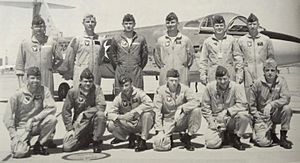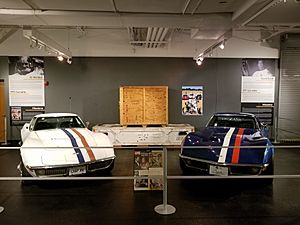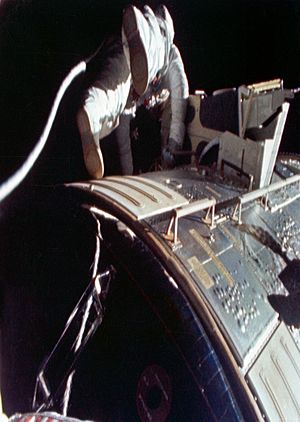Alfred Worden facts for kids
Quick facts for kids
Alfred Worden
|
|
|---|---|

Worden pictured in 1971
|
|
| Born |
Alfred Merrill Worden
February 7, 1932 Jackson, Michigan, U.S.
|
| Died | March 18, 2020 (aged 88) Sugar Land, Texas, U.S.
|
| Alma mater | United States Military Academy (BS) University of Michigan (MS) |
| Occupation |
|
| Awards | NASA Distinguished Service Medal |
| Space career | |
| NASA astronaut | |
| Rank | Colonel, United States Air Force |
|
Time in space
|
12d 07h 12m |
| Selection | 1966 NASA Group 5 |
|
Total EVAs
|
1 |
|
Total EVA time
|
38 minutes 12 Seconds |
| Missions | Apollo 15 |
|
Mission insignia
|
|
| Retirement | September 1, 1975 |
Alfred Merrill Worden (born February 7, 1932 – died March 18, 2020) was an American test pilot, engineer, and NASA astronaut. He was the pilot of the command module for the Apollo 15 mission to the Moon in 1971. He was one of only 24 people who have ever flown to the Moon. During his mission, he orbited the Moon 74 times in his spacecraft, called Endeavour.
Worden was born in Michigan in 1932. He grew up on farms and later attended the United States Military Academy at West Point, New York. After graduating in 1955, he joined the United States Air Force. He became a skilled fighter plane pilot and then a test pilot. In 1966, he was chosen to be a NASA astronaut. Before his Apollo 15 flight, he helped with the Apollo 9 and Apollo 12 missions.
During Apollo 15, his crewmates, David Scott and James Irwin, landed on the Moon. Worden stayed alone in the command module, orbiting the Moon for three days. He became the person who has traveled the farthest from any other human being. He took many photos of the Moon and used scientific tools to study it. On the way back to Earth, Worden performed a extravehicular activity (EVA), also known as a spacewalk. He went outside the spacecraft to get film from cameras. This was the first "deep space" spacewalk in history, and it remains the one farthest from Earth.
After their return, the crew faced a misunderstanding about some items they had carried to the Moon. They were later removed from future space missions. Worden stayed at NASA until 1975, working at the Ames Research Center. He then worked in business and helped the Astronaut Scholarship Foundation. He often spoke in public, encouraging support for space exploration and science education. He passed away in 2020.
Contents
Early Life and Education
Alfred Merrill Worden was born on February 7, 1932, in Jackson, Michigan. He was the second of six children. Al, as he was known, spent his early years on his family's farm. He also spent time at his grandparents' farm. He went to Jackson High School and became student council president. He was also a Boy Scout.
His family did not have a lot of money, so Worden looked for ways to get an education. He earned a scholarship to the University of Michigan for one year. He then decided that service academies were his best path. He was accepted into both the United States Military Academy at West Point, New York and the United States Naval Academy. He chose West Point, starting his studies in July 1951. Worden later said he didn't want to live on a farm forever. This led him on the path to NASA.
Worden enjoyed the challenging life at West Point. He studied hard and also participated in cross country running, gymnastics, and cheerleading. He earned a Bachelor of Science degree in military science from West Point in 1955. He finished 47th in his class of 470 students.
Becoming a Pilot
When Worden graduated from West Point, he had no flying experience. He chose to join the United States Air Force, thinking he would get promoted faster.
He began his flight training at Moore Air Force Base, Texas. There, he learned to fly on Beechcraft T-34 trainer planes. He quickly fell in love with flying. He continued his training on jet trainers and then on F-86D Sabres. From 1957 to 1961, he served as a pilot at Andrews Air Force Base near Washington, D.C.
In 1961, Worden decided to study aerospace engineering at the University of Michigan. He earned two Master of Science degrees in 1963: one in aerospace engineering and one in instrumentation engineering.
After his studies, Worden wanted to go to U.S. Air Force Test Pilot School. Instead, he was chosen for an exchange program with Britain's Royal Air Force. He trained at the Empire Test Pilots' School in England. He finished second in his class. After returning to the U.S., he became an instructor at the Aerospace Research Pilot School (ARPS). He graduated from ARPS in September 1965.
Joining NASA
Selection as an Astronaut
In 1963, Worden applied to join NASA's third group of astronauts. He was told he couldn't be chosen yet because of his training in England. He thought he would be too old for the next selection.
However, NASA began looking for its fifth group of astronauts in 1965. The age limit was raised, and Worden, who was 34, applied. He wrote that being an astronaut and flying in space was the best job he could imagine. In April 1966, Worden was one of 19 people chosen by NASA to become an astronaut.
Early Missions and Training
On October 3, 1966, Worden was assigned to a team working on the Block II command module (CM). These modules would be used for missions to the Moon. The next month, Worden joined the support crew for the second crewed Apollo mission. Support crews help the main and backup crews with tasks they don't have time for.
On January 27, 1967, Worden was at the factory where the command module was being built. He received a call saying that all three Apollo 1 astronauts had died in a fire during a test. Worden helped with the safety review that followed. He worked to remove dangerous materials from the Block II CM.
Worden later became part of the support crew for Apollo 9. This mission tested the command module and the Lunar Module (LM) in Earth orbit.
Worden was then named as the backup command module pilot (CMP) for the Apollo 12 flight. This meant he was likely to be the main CMP for Apollo 15. Jim Irwin was named the backup lunar module pilot (LMP) for Apollo 12, also with a good chance of flying on Apollo 15.
As the backup pilot for Apollo 12, Worden became good friends with the main pilot, Dick Gordon. They trained together for a year and a half. Worden said they worked hard but also had a lot of fun. They learned how to navigate the spacecraft in case they lost contact with Mission Control. The Apollo 12 crew had matching black and gold Chevrolet Corvettes. In response, the backup crew got a red car for Irwin, a white one for Worden, and a blue one for Scott. This showed their individual style.
The Apollo 15 Mission
Getting Ready for Space
Scott, Worden, and Irwin were announced as the crew of Apollo 15 on March 26, 1970. Apollo 15 was planned to be a "J mission." This meant it would have three moonwalks over three days, the first Lunar Roving Vehicle (LRV), and many scientific tools in the service module (SM). Worden's job was to operate these tools while his crewmates were on the Moon.
For the first time, studying the Moon from orbit was a main goal. Worden trained with geologist Farouk El-Baz. He learned to understand what he saw as he flew over different landscapes. Worden also went on geology training trips with his crewmates. They visited places that looked like the Moon's surface, such as sites in Hawaii, Mexico, and Iceland. He also trained for the chance that he might have to return without Scott and Irwin.
Before his mission, Worden appeared on the children's TV show Mister Rogers' Neighborhood. He believed NASA needed to connect more with children. Worden answered questions from children on the show. He even took some questions with him into space and answered them after his mission.
Apollo 15 launched from Kennedy Space Center (KSC) on July 26, 1971. Once the spacecraft was on its way to the Moon, Worden helped separate the command and service module (CSM), Endeavour, from the rocket booster. He then carefully guided Endeavour to connect with the lunar module (LM), Falcon.
Orbiting the Moon Alone
After the mission reached the Moon's orbit, Scott and Irwin went into Falcon. Worden stayed in Endeavour. When the two spacecraft had trouble separating, Worden went into the tunnel between them and fixed a loose cable. Worden listened as Scott and Irwin landed on the Moon. He later moved Endeavour into a higher orbit to begin his scientific work.
Worden's time alone in lunar orbit was like a separate mission. He had his own team of controllers on Earth. His main jobs were taking photos and using the scientific instruments. These tools included cameras, a laser, and devices to study the Moon's surface and gases. He also described what he saw. Each time Endeavour passed from the far side of the Moon back into communication with Earth, Worden would say, "Hello, Earth. Greetings from Endeavour" in different languages.
Even though he was busy, Worden took time to enjoy the experience. He knew he might not return to the Moon. He spent quiet moments looking out at the Moon, Earth, and the stars. He saw many more stars than people on Earth can see. He thought it was unlikely that Earth was the only place with life in the universe.
Worden is listed in the Guinness Book of World Records as the "most isolated human being." While orbiting the Moon alone, he was about 2,235 miles away from Scott and Irwin. This was the farthest any human has been from another human. He later said he enjoyed his "three wonderful days in a spacecraft all by myself." He was used to being alone as a fighter pilot. He remembered, "On the back side of the Moon, I didn't even have to talk to Houston and that was the best part of the flight."
The Journey Home
As Falcon took off from the Moon, Worden played a recording of the Air Force Song. He meant it only for Mission Control, but it was sent to the LM, which annoyed Scott. Worden then piloted the CSM as Scott guided the LM. They connected in orbit, which was the second time this had been done on the first try.
Endeavour completed 74 orbits around the Moon before heading back to Earth. On the way home, Worden performed a spacewalk to get film from the spacecraft's cameras. He spent 38 minutes outside Endeavour, going three times to the outside of the service module. This was the first spacewalk ever done in "deep space," far from Earth. Worden still holds the record for the spacewalk performed farthest from Earth. Apollo 15 ended with a splashdown in the Pacific Ocean. The crew was then picked up by the ship USS Okinawa. In total, Worden spent 295 hours and 11 minutes in space.
After NASA
After leaving the Air Force and NASA in 1975, Worden started his own company. He also worked as a director at the Northwood Institute in Michigan. In 1982, Worden ran for a seat in the United States House of Representatives in Florida. He lost the election, but he still called it a high point in his life. He said, "I thought that was a very important thing to do. I put everything into it and lost, but that is okay."
Worden later became involved with the Astronaut Scholarship Foundation. This group was started by the first astronauts to provide scholarships for students studying science. Worden became the chairman of its board of directors in 2005 and served until 2011.
Worden also held leadership roles at Jet Electronics and Technology, Inc., and with B.F. Goodrich. He retired from business in 1996. In 2011, his autobiography, Falling to Earth: An Apollo 15 Astronaut's Journey to the Moon, became a bestseller. He also wrote a poetry book, Hello Earth: Greetings from Endeavour (1974), and a children's book, I Want to Know About a Flight to the Moon (1974).
Al Worden was known for being friendly and easy to talk to. In 2018, he joined the Back to Space organization to inspire young people to go to Mars through films. He was also a consultant for the 2018 movie First Man, which was about Apollo 11's Neil Armstrong. In 2019, the Astronaut Al Worden Endeavour Scholarship was created. It sends young space explorers and their teachers to U.S. Space Camp in Alabama.
Awards and Honors
Worden received the NASA Distinguished Service Medal in 1971. He was inducted into the International Space Hall of Fame in 1983. In 1997, he was inducted into the United States Astronaut Hall of Fame. NASA honored him with the Ambassador of Exploration Award in 2009. In 2016, he was inducted into the International Air & Space Hall of Fame.
Worden and the other Apollo 15 crew members received the first United Nations Peace Medal in 1971. They also received the Robert J. Collier Trophy (1971) and other awards. He received an Honorary Doctor of Science degree from the University of Michigan in 1971.
Personal Life
Worden married Pamela Vander Beek in June 1955. They later divorced in December 1969. Worden became the first astronaut to divorce during the program and then fly in space. He remained involved in his daughters' lives.
He married Sandra Lee Wilder in September 1974, and they divorced in 1980. Worden married Jill Lee Hotchkiss in July 1982. She passed away in May 2014. He had two daughters, Merrill and Alison, with Pamela Worden, and one stepdaughter, Tamara, from his third marriage. Worden enjoyed bowling, water skiing, golf, racquetball, and playing the piano.
His Final Years
Worden passed away on March 18, 2020, at an assisted living center in Sugar Land, Texas. He was 88 years old. He had been recovering from an infection.
Many people shared tributes to Worden after his death. NASA Administrator Jim Bridenstine said, "Al was an American hero whose achievements in space and on Earth will never be forgotten." Buzz Aldrin, another Apollo astronaut, tweeted, "'Line of Grey, Be Thou at Peace!' Godspeed Al." Mike Pence, the Vice President of the United States, said, "We stand on the shoulders of space pioneers like Al, and America will always marvel at his achievements and look to him for inspiration."
A celebration of Worden's life was held online on September 19, 2020. Other astronauts, like Charles Duke, Fred Haise, and Jack Lousma, paid tribute to him.
Books
- Hello Earth; Greetings from Endeavour, Nash Publishing (1974), ISBN: 978-0-8402-1343-3
- I Want to Know About a Flight to the Moon, Doubleday (1974), ISBN: 978-0-385-05837-7
- Falling to Earth: An Apollo 15 Astronaut's Journey to the Moon with Francis French, Smithsonian Books (2011), ISBN: 978-1-58834-309-3
- Astronaut Al Travels to the Moon with Francis French, Illustrated by Michelle Rouch , Bookpress Publishing (2021), ISBN: 978-1-94730-527-4
- The Light of Earth: Reflections on a Life in Space with Francis French, University of Nebraska Press (2021), ISBN: 978-1-49622-865-9
See Also
 In Spanish: Alfred Worden para niños
In Spanish: Alfred Worden para niños







